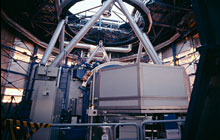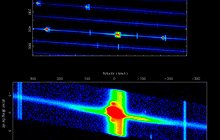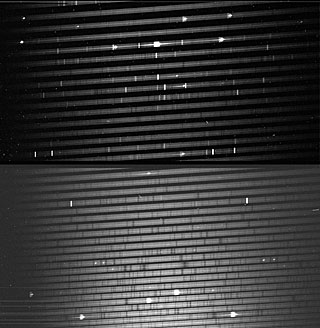UVES
Ultraviolet and Visual Echelle Spectrograph
Think of a tree, where the trunk splits into two main branches and each branch fans out into several smaller branches. Imagine now that the trunk is actually a beam of visible light, and the first split divides the light into red and blue colours. The light is further fanned out at every “branch” and “twig” as it passes through a prism, smearing the colours, so that the “leaves” — the end stage of the branching — form a beautiful rainbow.
You have just visualised the basics of what happens inside a cross-dispersion echelle spectrograph like UVES, which has been placed at the Nasmyth B focus of Unit Telescope 2 (UT2, Kueyen) of the Very Large Telescope at Paranal Observatory. The cultivator of this instrument, Lorenzo Monaco, ensures that UVES keeps blooming year after year.
 Inside UVES, the incoming beam of light is sent to either a blue (UV-to-blue) or a red (visible-to-red) arm — the two branches. Each of these arms goes through two perpendicular gratings, and each grating has a number of grooves which spread out the light by diffraction — the twigs. The larger the number of grooves at each branch, the stronger the variation in the colours between UVES’s “leaves”. This results in high spectral resolution.
Inside UVES, the incoming beam of light is sent to either a blue (UV-to-blue) or a red (visible-to-red) arm — the two branches. Each of these arms goes through two perpendicular gratings, and each grating has a number of grooves which spread out the light by diffraction — the twigs. The larger the number of grooves at each branch, the stronger the variation in the colours between UVES’s “leaves”. This results in high spectral resolution.
When combined with the fibre system FLAMES (another spectrograph installed on UT2), UVES transforms from a single tree into a clump of trees! The two instruments together can provide this kind of high resolution spectroscopy for up to eight different objects at the same time through fibres fed through the red arm. “UVES is then a multi-purpose instrument capable of handling a wide variety of astronomical topics, ranging from Solar System objects to the most distant Universe,” says Lorenzo. “If you need high resolution to observe faint objects, UVES is most likely the instrument you are looking for.”
UVES has provided us with a forest-full of detailed spectroscopic data of an impressive variety of objects — from stars inside our galaxy, the Milky Way, to distant galaxies and gamma-ray bursts. For example, Lorenzo tells us that “over the years, UVES observations were extremely important in the study and characterisation of the most metal-poor stars in the Universe. These objects are among the first generations of stars to have formed and provide information about the conditions of the early Universe.” With discoveries like these, the importance of UVES will only grow further!
Science highlights with UVES
- Remains of a fatal interaction between a dead star and its asteroid supper studied in detail for the first time (eso1544)
- UVES finds the oldest solar twin to date (eso1337)
- Best direct observational evidence found so far supporting the theory that galaxies pull in and devour nearby material in order to grow and form stars (eso1330)
- UVES helps us realise that the brightest stars always come in interacting pairs (eso1230)
- A molecular thermometer determines that the temperature of the Universe 11 billion years ago was -264 degrees C (eso0813)
- The most luminous object ever observed in the Universe is observed and found to be 7.5 billion light-years away (eso0808)
|
This shows the raw image, as read from one of the detectors in UVES, with the recorded spectrum of famous supernova SN1987A. With this technique, the supernova spectrum is divided into many individual parts (spectral orders, each of which appears as a narrow horizontal line) that cover wavelengths ranging from the blue (at the bottom) to the red (at the top). Many bright emission lines from different elements are visible, e.g., the strong H-alpha line from hydrogen near the centre of the fourth order from the top. The pseudocolour image further up this page is a small section of this spectrum. |
UVESThe authoritative technical specifications as offered for astronomical observations are available from the Science Operation page.
|


